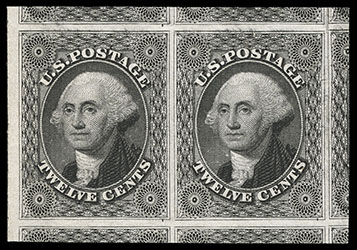
Lot
1410 

1851, 12¢ gray black, horizontal pair on part India paper, o.g., never hinged, huge margins showing seven adjoining stamps on three sides and sheet margin at left, deeply etched impressions on brilliant paper, exceptionally fresh and Superb pair; with 2018 P.F. and P.S.E. certificates, both Graded (Superb 100J). Scott No. 17 $17,500 as o.g.
AN EXTRAORDINARY MINT NEVER HINGED PAIR OF THE 12¢ 1851 IMPERFORATE IN THE FINEST CONDITION
THE SMQ VALUE FOR A SINGLE GRADED 100J IS A STAGGERING $165,000, A PAIR IS UNPRICED.
The postal Act of March 3, 1851, was to provide for relatively inexpensive postage and new graduated postal rates coupled with the issuance of new 1¢, 3¢, and 12¢ stamps. The new rates of July 1851 did not include a basic single rate that would require a 12¢ stamp. The prepaid letter rate of 3¢ per half ounce up to 3,000 miles, or 6¢ beyond, and 1¢ for printed circulars. As such, the 12¢ value could only prepay multiple rates such as four times the 3¢ letter rate for up to 3,000 miles, or double the 6¢ rate for over 3,000 miles. There were no 12¢ rates even in foreign mails. For a time, the stamps were cut in half and accepted as 6¢ on letters from California. The only transatlantic postage rate listed in the 1851 Postal Guide that is a listed multiple of 12¢ is to Great Britain (24¢), which turns out to be the most common use of the stamp.
Toppan, Carpenter, Casilear & Co. engraved the plates and printed the 1¢, 3¢ and 12¢ 1851 stamps in time for the July 1 issue date. While official government records reveal that the denominations were distributed to many post offices on or about July 1, 1851, the earliest confirmed usage of the 12¢ value is August 4, 1851. Moreover, while the Post Office had delivered over 230,000 stamps by June 30, 1852, there are only about a dozen uses documented for the entire last six months of 1851. This is in contrast to the 1¢ and 3¢ stamps, for which numerous first day of issue covers are known to exist as well as hundreds or thousands of covers from 1851. The number of dated uses for the 12¢ stamps gradually increased in 1853 and beyond. Eventually, about 800,000 imperforate stamps were to be distributed. The imperforate 12¢ stamps were in use until mid-1857, when perforations were introduced. Plate 1 was used to print 12¢ stamps until Plate 3 was put into use in 1860, the latter only used for the perforate issue.
